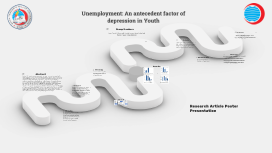Poster Presentation of Research Article
Transcript: Unemployment: An antecedent factor of depression in Youth Group Members References Asma Yousaf, Muhammad Huzaifa Ammar, Maleeha Rasheed, Mateen Nawaz, Talha Mahmood Mokona H, Yohannes K, Ayano G. Youth unemployment and mental health: prevalence and associated factors of depression among unemployed young adults in Gedeo zone, Southern Ethiopia. Int J Ment Health Syst. 2020 Aug 8;14:61. doi: 10.1186/s13033-020-00395-2. PMID: 32782471; PMCID: PMC7414568. Navarro-Abal Y, Climent-Rodríguez J, López-López M, Gómez-Salgado J. Psychological coping with job loss. Empirical study to contribute to the development of unemployed people. Int J Environ Res Public Health. 2018;15(8):1787. Conclusion The results of this study indicated that depression is an important public health problem among unemployed young adults in Geode zone, southern Ethiopia. Being male, long duration of unemployment, low self-esteem, poor social support, and current alcohol use were statistically significant with depression. For resolving this problem, the study suggests that the appropriate strategies should be establish for prevention, early detection and management of depression among unemployed young adults. References Recommendations Job Creation and Training Programs Psychological support and awareness Financial Assistance and Welfare Programs American Psychiatric Association. (2013). Diagnostic and statistical manual of mental disorders (5th ed.). https://doi.org/10.1176/appi.books.9780890425596. Brydsten A, Hammarström A, San Sebastian M. The impact of economic recession on the association between youth unemployment and functional somatic symptoms in adulthood: a difference-in-difference analysis from Sweden. BMC Public Health. 2016;16(1):230. Christofersen MN, Poulsen HD, Nielsen A. Attempted suicide among young people: risk factors in a prospective register based study of Danish children born in 1966. Acta Psychiatr Scand. 2003;108(5):350–8. Crowe L, Butterworth P. The role of financial hardship, mastery and social support in the association between employment status and depression: results from an Australian longitudinal cohort study. BMJ Open. 2016;6(5):e009834. Results Methodology A cross-sectional study in Gedeo zone, Southern Ethiopia (May-July 2019) surveyed 1452 unemployed young adults who were selected through systematic random sampling. Depression was assessed with Patient Health Questionnaire-9 (PHQ-9), and socio-demographic data was collected via structured questionnaires. Abstract Ethiopia's 25.3% youth unemployment rate in 2018 raises concerns about mental health, notably depression. Yet, no studies have explored depression prevalence and factors among unemployed Ethiopian youth. This article highlights the prevalence and associated factors of depression among unemployed young adults in Gedeo zone, Southern Ethiopia. A community-based cross-sectional study was conducted among 1452 unemployed young adults in Gedeo zone, Southern Ethiopia, from May to July 2019. Data analysis was performed using Epi-Data version 3.1 and SPSS version 20, utilizing multivariable logistic regression analysis. Systematic random sampling technique was used for sample recruitment. Depression was assessed using the Patient Health Questionnaire-9 (PHQ-9), and socio-demographic data were collected via a structured questionnaire. The study found an overall depression prevalence of 30.9%, with 56.7% experiencing mild depression, 36% moderate depression, and 7.3% severe depression. This study underscores depression as a critical public health issue among unemployed young adults in Ethiopia. . Introduction Unemployment in youth is associated with depression, worsened physical health, increased criminal activities, and elevated risks of substance abuse. Factors such as prolonged joblessness, low self-esteem, limited social support, and substance abuse contribute to this phenomenon, leading to heightened vulnerability to psychological crises (Crowe and Butterworth, 2016; Brydsten et al., 2016; Christofersen et al., 2001) This study is the first to assess the prevalence and associated factors of depression among unemployed young adults in Ethiopia's Gedeo zone, aiming to inform health programmers and policymakers about designing preventive strategies and intervention programs for mental health problems in this demographic Methodology Research Article Poster Presentation Introduction Major depressive disorder is a common and serious medical illness that negatively affects how you feel the way you think and how you act (APA, 2013). Feelings of failure due to economic strain from unemployment often result in depression, while family and societal pressures on job-seeking efforts and higher expectations for employment among young graduates can exacerbate this mental health issue (Mokona et al., 2020). In a cross-sectional study in Spain by Navarro et al. (2018), it was found that among 244 unemployed individuals, 41.8% experienced mild depression, 42.2%

















